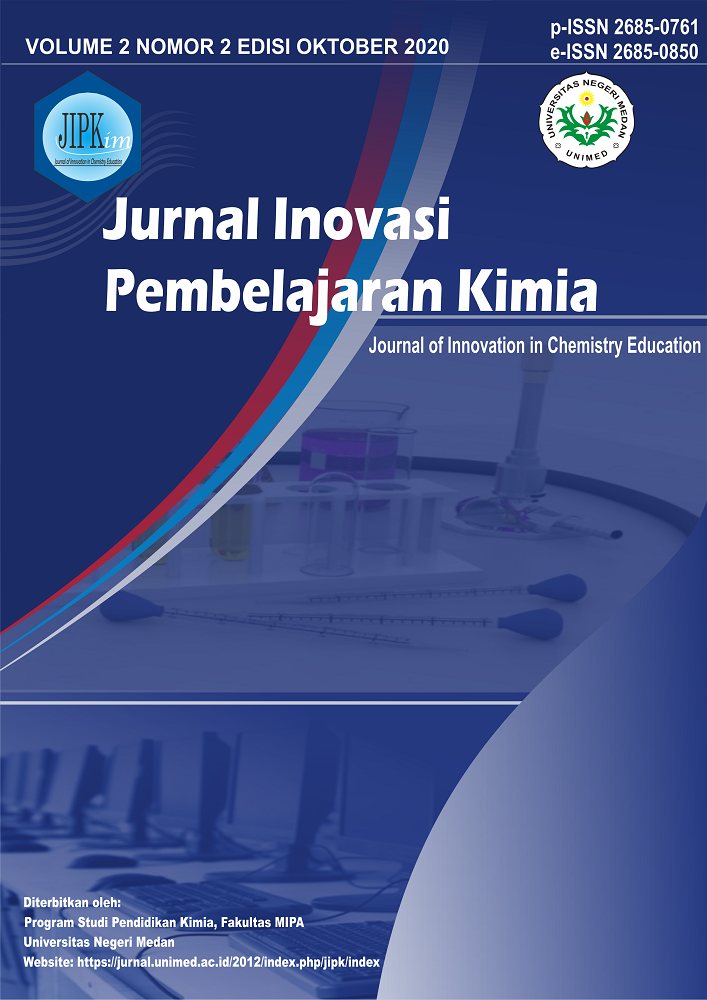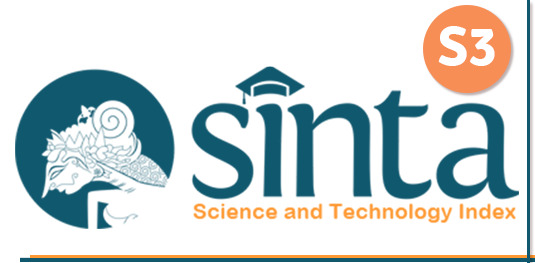Pengembangan Bahan Ajar Berbasis Proyek Di SMA Negeri 2 Lintongnihuta pada materi Asam dan Basa
DOI:
https://doi.org/10.24114/jipk.v2i2.19619Keywords:
Teaching Materials, Learning Outcomes, Project Based Learning, Acid and BaseAbstract
This study aims to determine the feasibility of project-based chemical teaching materials and increase student learning outcomes on acid-base material using project-based teaching materials and adobe flash multimedia at SMA Negeri 2 Lintongnihuta. This type of research is research and development. This study uses a one-group pretest-posttest design. Data were processed descriptively, obtained the average value of the validation of the modules developed, namely the content eligibility of 3.62; presentation 3.67; language 3.72; and graphic 3.72; with an average of 3.68. Data collection techniques for student learning outcomes by providing pretest and post-test. For the pretest data the experimental class was 48.11 and the repetition class was 46.47, while the post-test data were the experimental class 84.11 and the repetition class 81.32. The mean percentage of improvement in student learning outcomes in the experimental class was 68% and the repetition class was 65%. Hypothesis testing with the right-side t test at the level of α = 0.05 obtained> (7.99> 1.697 (experimental) and 6.65> 1.697 (repetition)) which means that the chemical module integrated project-based learning with adobe flash multimedia developed it is good and in accordance with BSNP criteria standards and is suitable for use.References
Doppelt, Y. (2005). Assessment of Project- Based Learning in a Mechatronics Context. International Journal of Technology Education, 16(2), 7-24.
Haryani, S., Wardani, S., & Prasetya, A. T. (2018). Analisis Kemampuan Penyusunan Lembar Kerja Siswa Berbasis Problem Based Learning dan Project Based Learning. Jurnal Inovasi Pendidikan Kimia, 12(1), 2086“2096. https://journal.unnes.ac.id/nju/index.php/JIPK/article/view/13300/7366.
Kartini, K. S. (2019). Pengaruh Model Pembelajaran Kooperatif Tipe Think-Pair-Share Terhadap Hasil Belajar Kimia Siswa Kelas X. Jurnal Redoks ( Jurnal Pendidikan Kimia Dan Ilmu Kimia ), 2(01), 29“33. https://doi.org/10.33627/re.v2i01.110.
Nurfitriyanti, M. (2016). Model Pembelajaran Project Based Learning Terhadap Kemampuan Pemecahan Masalah Matematika. Jurnal Formatif, 6(2), 149“160. https://journal.lppmunindra.ac.id/index.php/Formatif/article/view/950/883.
Rachmatia, E., Aunurrahman, & Usman, A. (2016). Pengembangan Modul Pembelajaran Kimia untuk Kecakapan Membangun dan Menggunakan Konsep Redoks dan Hidrokarbon Kelas X SMAN 3 Sungai Kakap. Journal Of Prospective Learning, 2(1), 27“36. http://jurnal.untan.ac.id/index.php/lp3m/article/download/19212/16054.
Redhana, I. W. (2019). Mengembangkan Keterampilan Abad Ke-21 Dalam Pembelajaran Kimia. Jurnal Inovasi Pendidikan Kimia, 13(1), 2239“2253.
Rezeki, R., Nurhayati, N., & Mulyani, S. (2015). Penerapan Metode Pembelajaran Project Based Learning (Pjbl) Disertai Dengan Peta Konsep Untuk Meningkatkan Prestasi Dan Aktivitas Belajar Siswa Pada Materi Redoks Kelas X-3 Sma Negeri Kebakkramat Tahun Pelajaran 2013 / 2014. Jurnal Pendidikan Kimia Universitas Sebelas Maret, 4(1), 74“81.
Surya, A. P., Relmasira, S. C., & Hardini, A. T. A. (2018). Penerapan Model Pembelajaran Project Based Learning (PjBL) Untuk Meningkatkan Hasil Belajar Dan Kreatifitas Siswa Kelas Iii Sd Negeri Sidorejo Lor 01 Salatiga. Jurnal Pesona Dasar, 6(1), 41“54. https://doi.org/10.24815/pear.v6i1.10703.
Titu, M. A. (2015). Penerapan Model Pembelajaran Project Based Learning (PjBL) Untuk Meningkatkan Kreativitas Siswa Pada Materi Konsep Masalah Ekonomi. Prosiding Seminar Nasional, 176“186. http://eprints.uny.ac.id/id/eprint/21708.













